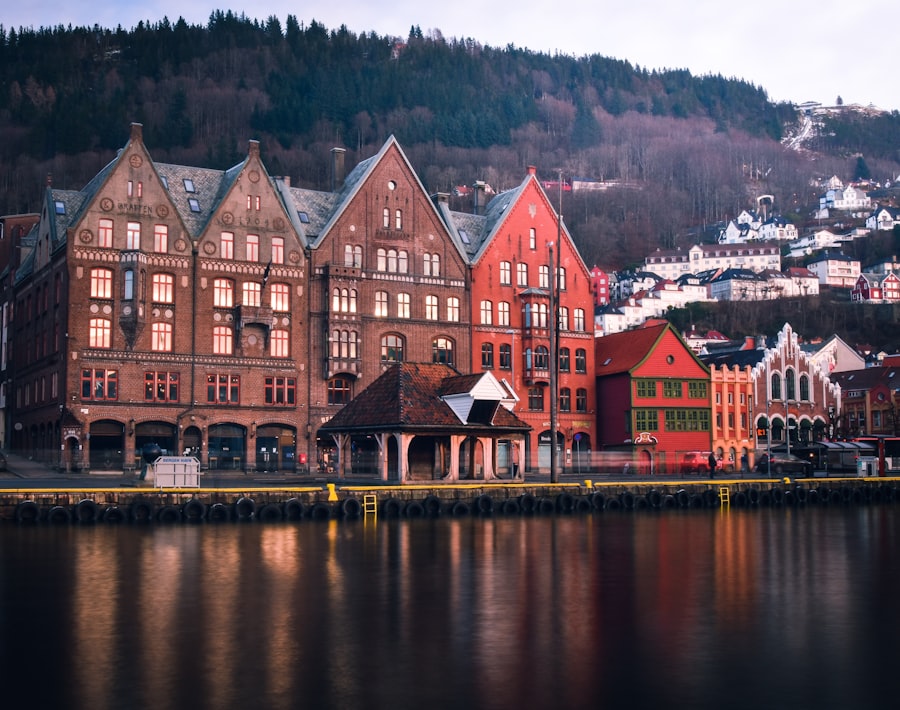Kransekake, a delightful and visually striking cake, holds a special place in Norwegian culinary tradition. This iconic dessert, often associated with celebrations and festive occasions, is a true testament to the artistry of Norwegian baking. Characterised by its unique ring-shaped structure, Kransekake is not only a treat for the taste buds but also a feast for the eyes.
Its almond-based composition and sweet, chewy texture make it a beloved choice for many Norwegians and those who have had the pleasure of tasting it. The cake’s name translates to “ring cake,” aptly describing its distinctive form. Traditionally, Kransekake is made from a simple yet elegant combination of ground almonds, sugar, and egg whites, resulting in a gluten-free dessert that is both rich and satisfying.
As we delve deeper into the history, preparation, and cultural significance of Kransekake, it becomes clear that this cake is more than just a dessert; it is a symbol of celebration, community, and tradition in Norway. Your journey to a smooth relocation starts here. Talk one-on-one with a Norway Relocation specialist and turn your plan into a reality.
Summary
- Kransekake is a traditional Norwegian cake made of stacked rings, often served at special occasions and celebrations.
- The origins of Kransekake can be traced back to the 18th century in Denmark, and it has since become a popular dessert in Norway.
- The main ingredients for Kransekake include almonds, sugar, and egg whites, and the preparation involves shaping the dough into rings and baking them to a golden brown.
- The traditional design of Kransekake consists of 18 to 20 rings, with the largest ring at the bottom and the smallest at the top, often decorated with flags or ornaments.
- Kransekake holds great significance in Norwegian culture, symbolizing good luck, prosperity, and unity, and is often featured at weddings, Christmas, and New Year celebrations.
History and Origins of Kransekake
The origins of Kransekake can be traced back several centuries, with its roots deeply embedded in Scandinavian history. While the exact timeline remains somewhat elusive, it is widely believed that the cake emerged during the Middle Ages. Initially, it was crafted as a luxurious treat for the nobility, showcasing the wealth and status of those who served it at their feasts.
Over time, Kransekake transitioned from an exclusive delicacy to a beloved staple at various celebrations across Norway. Interestingly, Kransekake is not solely a Norwegian creation; variations of this cake can be found throughout Scandinavia, particularly in Denmark and Sweden. Each country has its own interpretation of the recipe and presentation, but the core elements remain consistent.
The cake’s enduring popularity can be attributed to its versatility and the way it embodies the spirit of togetherness during festive occasions. As we explore its ingredients and preparation methods, we will uncover how this traditional cake has evolved while retaining its cultural significance.
The Ingredients and Preparation of Kransekake

The beauty of Kransekake lies in its simplicity, with just a handful of ingredients required to create this exquisite dessert. The primary components include finely ground almonds, sugar, and egg whites. The use of almonds not only imparts a rich flavour but also contributes to the cake’s chewy texture.
Some recipes may incorporate a hint of vanilla or lemon zest to enhance the overall taste profile, but the classic version remains true to its almond roots. Preparing Kransekake involves a meticulous process that requires both patience and precision. The ground almonds are combined with sugar to form a dough-like consistency, which is then shaped into rings of varying sizes.
These rings are stacked upon one another to create the iconic tiered structure that defines Kransekake. Once assembled, the cake is often adorned with a sweet icing made from powdered sugar and egg whites, adding an extra layer of sweetness and visual appeal. The preparation process may seem daunting at first, but with practice and attention to detail, anyone can master the art of creating this traditional Norwegian cake.
The Traditional Design and Structure of Kransekake
The design of Kransekake is one of its most captivating features. Traditionally, the cake consists of multiple rings stacked on top of one another, creating a towering structure that can reach impressive heights. The number of rings can vary depending on personal preference or occasion; however, it is common to see anywhere from 18 to 25 rings in a single cake.
Each ring is carefully crafted to ensure uniformity in size and shape, contributing to the overall aesthetic appeal. In addition to its tiered design, Kransekake is often embellished with decorative elements that enhance its festive appearance. Common adornments include marzipan figures, edible flowers, or even small flags representing special occasions or celebrations.
The icing that coats the cake can be piped into intricate patterns or used to create delicate designs that further elevate its visual impact. This attention to detail not only showcases the baker’s skill but also reflects the importance of presentation in Norwegian culture.
The Significance of Kransekake in Norwegian Culture
Kransekake holds profound cultural significance in Norway, serving as a symbol of celebration and togetherness. It is often featured at major life events such as weddings, christenings, and anniversaries, where it acts as a focal point for gatherings of family and friends. The act of sharing Kransekake during these occasions fosters a sense of community and connection among those present.
Moreover, Kransekake is steeped in tradition and folklore. It is believed that the cake brings good luck and prosperity to those who partake in it. This belief has contributed to its enduring presence at festive events throughout Norway.
As families gather around the cake to celebrate milestones and achievements, they not only indulge in its deliciousness but also honour their heritage and the bonds that unite them.
Kransekake for Weddings and Special Occasions

One of the most cherished uses for Kransekake is at weddings, where it serves as a stunning centrepiece that embodies love and commitment. Traditionally, the bride and groom cut the first slice together as a symbol of their union, sharing this sweet moment with their guests. The towering structure of the cake represents the couple’s aspirations for a prosperous future together.
In addition to weddings, Kransekake is also popular at other significant life events such as christenings and milestone birthdays. Its presence at these gatherings signifies joy and celebration, making it an essential part of Norwegian festivities. Families often pass down their Kransekake recipes through generations, ensuring that this beloved tradition continues to thrive within their households.
Kransekake for Christmas and New Year Celebrations
During the festive season, Kransekake takes on an even more prominent role in Norwegian culture. It is commonly served at Christmas gatherings and New Year celebrations, where its sweet flavour complements the array of traditional holiday treats. The cake’s elegant appearance makes it an ideal choice for festive tables adorned with decorations and seasonal delights.
In many households, baking Kransekake becomes a cherished family activity during the holiday season. Families come together to create their own versions of this traditional cake, often experimenting with different flavours or decorative elements. This shared experience not only strengthens familial bonds but also reinforces the importance of tradition during this special time of year.
Variations and Modern Twists on the Traditional Kransekake Recipe
While traditional Kransekake remains beloved by many, modern bakers have begun to experiment with variations that add new dimensions to this classic dessert. Some have introduced alternative flavours such as chocolate or citrus zest to create unique twists on the original recipe. Others have incorporated different types of nuts or even gluten-free flour blends to cater to diverse dietary preferences.
Additionally, contemporary presentations have emerged that challenge the traditional tiered structure. Some bakers opt for smaller individual servings or creative shapes that reflect personal styles or themes for specific occasions. These innovations demonstrate how Kransekake continues to evolve while still honouring its rich heritage.
Tips for Making and Decorating Kransekake at Home
For those eager to try their hand at making Kransekake at home, there are several tips that can help ensure success. First and foremost, using high-quality ingredients is essential; fresh almonds will yield better flavour and texture than older ones. Additionally, precise measurements are crucial when combining ingredients to achieve the right consistency for shaping the rings.
When it comes to decorating Kransekake, creativity knows no bounds. Bakers can experiment with different icing techniques or embellishments to personalise their cakes for specific occasions. Using piping bags allows for intricate designs that can elevate the overall presentation significantly.
Finally, patience is key; allowing the cake to cool completely before decorating will ensure that the icing adheres properly without melting or sliding off.
Serving and Enjoying Kransekake at Celebrations
Serving Kransekake at celebrations is an event in itself; its impressive stature often draws admiration from guests before they even take their first bite. Traditionally, slices are cut from the bottom ring upwards, allowing everyone to enjoy a piece while preserving the overall structure for as long as possible. This method not only maintains the cake’s aesthetic appeal but also ensures that each guest receives a fair share.
As guests savour their slices of Kransekake, they are often treated to conversations about family traditions or memories associated with this beloved dessert. Sharing stories while enjoying this sweet treat enhances the sense of community that Kransekake embodies during celebrations.
Where to Find and Buy Kransekake in Norway and Beyond
For those who wish to experience Kransekake without embarking on a baking adventure themselves, numerous bakeries across Norway offer this traditional cake for purchase. From quaint local shops to larger patisseries in major cities like Oslo and Bergen, finding a beautifully crafted Kransekake is relatively easy. Moreover, many bakeries now offer online ordering options for those living outside Norway who wish to indulge in this delightful dessert from afar.
With just a few clicks, one can have a slice of Norwegian tradition delivered right to their doorstep—an excellent way to share this cultural treasure with friends and family around the world. In conclusion, Kransekake stands as a symbol of celebration within Norwegian culture—a dessert steeped in history yet continually evolving with modern influences. Whether enjoyed at weddings or festive gatherings during Christmas and New Year celebrations, this traditional cake brings people together through shared experiences and cherished memories.
As you embark on your own journey with Kransekake—whether baking it at home or seeking it out from local bakeries—may you find joy in every bite and connection in every celebration.
Register for a Norwegian class at the NLS Norwegian Language School now!

